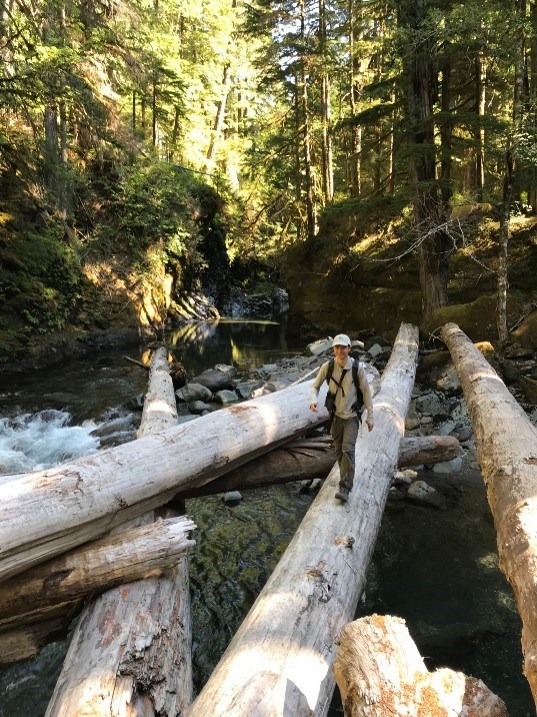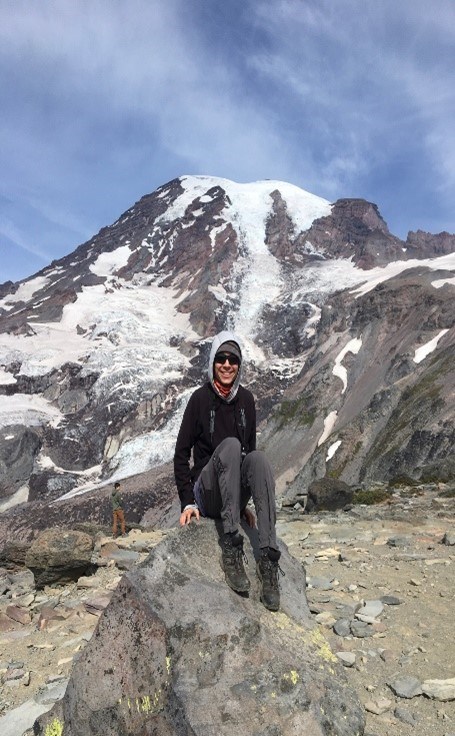Last updated: February 24, 2025
Article
Intern Spotlight: Kai Victor

Photo courtesy of Kai Viktor
How did you find yourself at the National Park Service?
I’ve always been extremely passionate about wildlife conservation and the natural world since childhood! Although I grew up in urban New York City, my parents shared their love for the outdoors with me and taught me the joys of wandering along forested trails and observing wildlife. Visiting national parks was always a really special experience for my family, and I have wonderful memories of seeing bald eagles in Yellowstone National Park and grizzly bears in Glacier National Park. I graduated in 2021 from Cornell University after majoring in Environmental Science. I have been fortunate enough to have worked on field research projects around the world (mainly involving birds). I had a friend who had previously worked at a national park through the Mosaics in Science Diversity Internship Program (MIS). After hearing about her wonderful experiences living, working, and learning in such a unique location, I was hooked! Although I primarily had a background in avian biology, I noticed that MIS was offering an internship position studying imperiled mesocarnivores, bats, and Northern spotted owls at Mount Rainier National Park. This seemed like a wonderful chance to get experience with new research techniques, extend my skills to involve new taxa, and learn more about the role of conservation research within the National Park Service. Fast forward several months, and I found myself driving all the way from New York to Washington state. As I saw the snow-covered summit of Mount Rainier National Park towering over the conifer-laden hillsides, heard the song of American dippers mingling with croaking ravens, and caught the first of many trout from a park stream, I knew I was in for an epic internship.
Photo courtesy of Kai Victor
What has been the highlight of your experience as an intern with the National Park Service?
I could write a whole essay answering this one question and it still wouldn’t be enough! I guess the natural first place to start is with the park. Working (and living!) within Mount Rainier National Park was an experience I will treasure for the rest of my life. I never realized how unique, complex, and diverse a national park could be until I’d spent five months living in one and still found myself observing new things each day. With fly fishing, hiking, birding, and naturalisting to occupy my free time, I was constantly learning and discovering with every second I spent outdoors. From alpine meadows and glacial valleys to turquoise rivers and quiet mossy glades, I felt incredibly fortunate to be able to spend a solid chunk of time under the shadow of timeless Mount Rainier. That’s not to say that the environment was untouched by people. As one of the more developed national parks, Mount Rainier has a fairly extensive system of roads and trails, allowing easy access to many areas of the park. Of course, this led to inevitable trash along pathways and trampling of vegetation. But these were outweighed by the appreciation many visitors displayed for the ecosystems through picking up garbage and sharing interesting observations with each other. I feel like this is a natural transition to talking about the people of Mount Rainier, who were equally special! Everyone I met who worked at the park was passionate about what they did, and loved having the chance to do their job. Going on a stroll with my coworkers generally involved the sound of botanists squealing over blooming ephemerals, biologists sprinting after butterflies, and geologists pointing out various types of rocks. I’m still friends with people I got to know while in Washington, and I love hearing about all of their adventures and research projects! Speaking of research, the quantity and quality of science done at Mount Rainier was mind-boggling. Prior to this internship, I’d never known that research was done within the national park system. Like many tourists, I simply assumed that the only NPS employees were the ones wearing big hats behind visitor center desks. It’s an easy mistake to make, as many of the people doing research are not where the tourists tend to go! During my internship, I had the chance to take part in a multitude of different projects, from tracking wolves in North Cascades National Park to surveying spawning Bull trout in glacial streams. The skills I learned were endless, the sights I saw were awe-inspiring, and the research we did had concrete conservation implications aimed at protecting the flora and fauna of the mountain I was able to call home.What is it like cultivating a community as a National Park Service intern?
It’s always intimidating to begin a new job, and even more so to begin a field job in (relatively) the middle of nowhere. Coming from New York, I knew moving to Mount Rainier would be a big transition. When I arrived, I knew no one. A week later, I felt like I was part of a family. Something about taking a bunch of avid scientists and dropping them down in the woods together lends itself well to late-night discussions of salamander speciation around a fire or weekend expeditions to see if the Brook trout in a lake really were as big as was rumored. The ruralness of my new home at Mount Rainier made it feel like I had been transported back in time. With no cell service or city distractions, life took on a much slower and more friendly pace. With no one around, doors could be left open, and plans were made by showing up randomly at someone's house or leaving a handwritten note under a moss-covered rock near their porch. I was fortunate to have instant friends in my crew, my housemates, and my fellow interns. I really appreciated how many people went out of their way to make sure I felt welcome as an intern! From being included in meetings to having the ability to structure my schedule and work around topics and skills that most interested me, I felt like I was a true member of the National Park Service team at the park.What projects have you been involved in so far?
The work during my internship mainly fell into three categories. Primarily, we focused on surveying Mount Rainier National Park for Northern spotted owls through callback surveys and autonomous recording unit deployment. I was also able to co-lead an initiative to resurvey historical Northern spotted owl nest trees to determine their current status. Another portion of my job consisted of studying the occurrence of White-nose syndrome in local bat populations. This involved roost visits, mist netting and banding bats, and tracking them with telemetry. Lastly, I assisted with mesocarnivore monitoring to track populations of wolverine, fisher, and Cascade red fox in the area through scat collection, bait station deployment, and camera trap setup. In addition to my work with Mount Rainier’s wildlife crew, I was able to join other local crews to gain extra experience, which allowed me to get involved with old-growth forest monitoring, trout sampling, amphibian surveying, and small mammal trapping. Although I was based at Mount Rainier, I even had the opportunity to help out with projects outside the park system and within two other national parks (North Cascades National Park and Olympic National Park). This gave me a chance to work with teams of collaborators composed of federal, state, non-profit, and private partners.
Photo courtesy of Kai Victor
